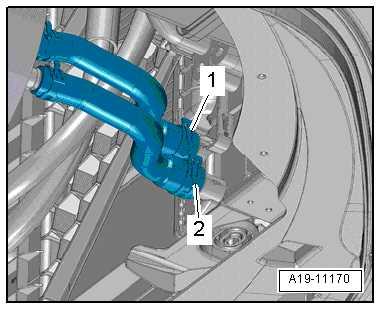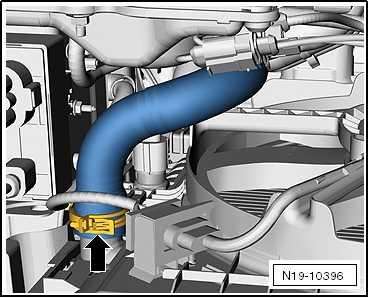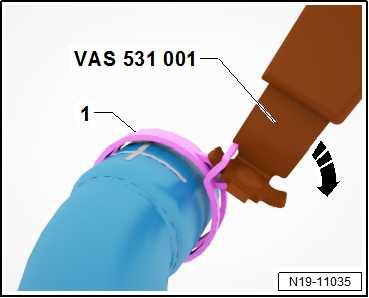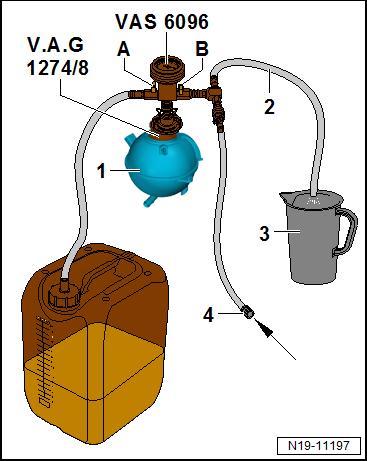
3 minute read
2.2 Assembly overview - electric coolant pump
Note
♦ The water used for mixing has a major influence on the effec‐tiveness of the coolant. Because the water quality differs from country to country and even from region to region, the quality of the water to be used in the cooling system has been speci‐fied by Volkswagen. Distilled water fulfils all requirements. Therefore, always use only distilled water when mixing coolant for topping up or renewing coolant. ♦ Use only coolant additives which conform with the ⇒ Elec‐tronic parts catalogue (ETKA) . Other coolant additives may reduce corrosion protection substantially. The resulting dam‐age could lead to loss of coolant and subsequent severe damage to the motor. ♦ Mixed in the proper proportions, coolant inhibits frost and cor‐rosion damage as well as scaling. It also raises the boiling point of coolant. For this reason, the cooling system must be filled all-year-round with coolant additives. ♦ Because of its high boiling point, the coolant improves engine reliability under heavy loads, particularly in countries with trop‐ical climates.
♦ Use ONLY refractometer - T10007A- for determining current anti-freeze value.
♦ The frost protection must be effective down to at least -25 °C, and approx. -36 °C in cold countries. The effectiveness of the frost protection may only be increased if a higher level of frost protection is required due to the climate. It may, however, be increased only to a maximum of -48°C. Otherwise, the cooling effect will be impaired. ♦ Do not reduce the coolant concentration by adding water even in warmer seasons and in warmer countries. Frost protection must be guaranteed down to at least -25 °C. ♦ Read off anti-freeze figures for respective replenished coolant additives.
♦ The temperature read off the refractometer - T10007A- corre‐sponds the »ice flocculation point«. Flakes of ice may start forming in the coolant at this temperature. ♦ Never reuse old coolant.
♦ Use only a water/coolant additive mixture as a slip agent for coolant hoses.
Protected by copyright. Copying for private or commercial purposes, in part or in whole, is not permitted unless authorised by SEAT S.A. SEAT S.A does not guarantee or accept any liability with respect to the correctness of information in this document. Copyright by SEAT S.A.

Coolant mixture ratio
• Coolant (40 %) and distilled water (60 %) for frost protection to -25 °C
• Coolant (50 %) and distilled water (50 %) for frost protection to -36 ℃
• Coolant: ⇒ Electronic parts catalogue (ETKA)
Procedure
– Connect coolant hoses to water radiator for charge air cooler using hose clips -1 and 2-.
Note
The design of the clip -arrow- is different from that of conventional clips and requires a special tool for the clip to be engaged.
– Push coolant hose with clip -arrow- onto radiator at bottom.
– Engage clip -1- in direction of -arrow- using release tool - VAS 531 001- .
– Fill coolant reservoir of -VAS 6096- with at least 8 litres of premixed coolant in correct mixture ratio:
– Screw adapter for cooling system tester - V.A.G 1274/8- onto coolant expansion tank. – Mount cooling system charge unit - VAS 6096- on adapter V.A.G 1274/8- .
– Feed vent hose -2- into a small container -3-.
Note
Protected by copyright. Copying for private or commercial purposes, in part or in whole, is not permitted unless authorised by SEAT S.A. SEAT S.A does not guarantee or accept any liability with respect to the correctness of information in this document. Copyright by SEAT S.A.

Exhaust air takes a slight quantity of coolant along with it; this should be collected.
– Close both valves -A- and -B- and turn the lever so that it is at right angles to direction of flow. – Connect hose -4- to compressed air supply. • 6 ... 10 bar of working pressure.














